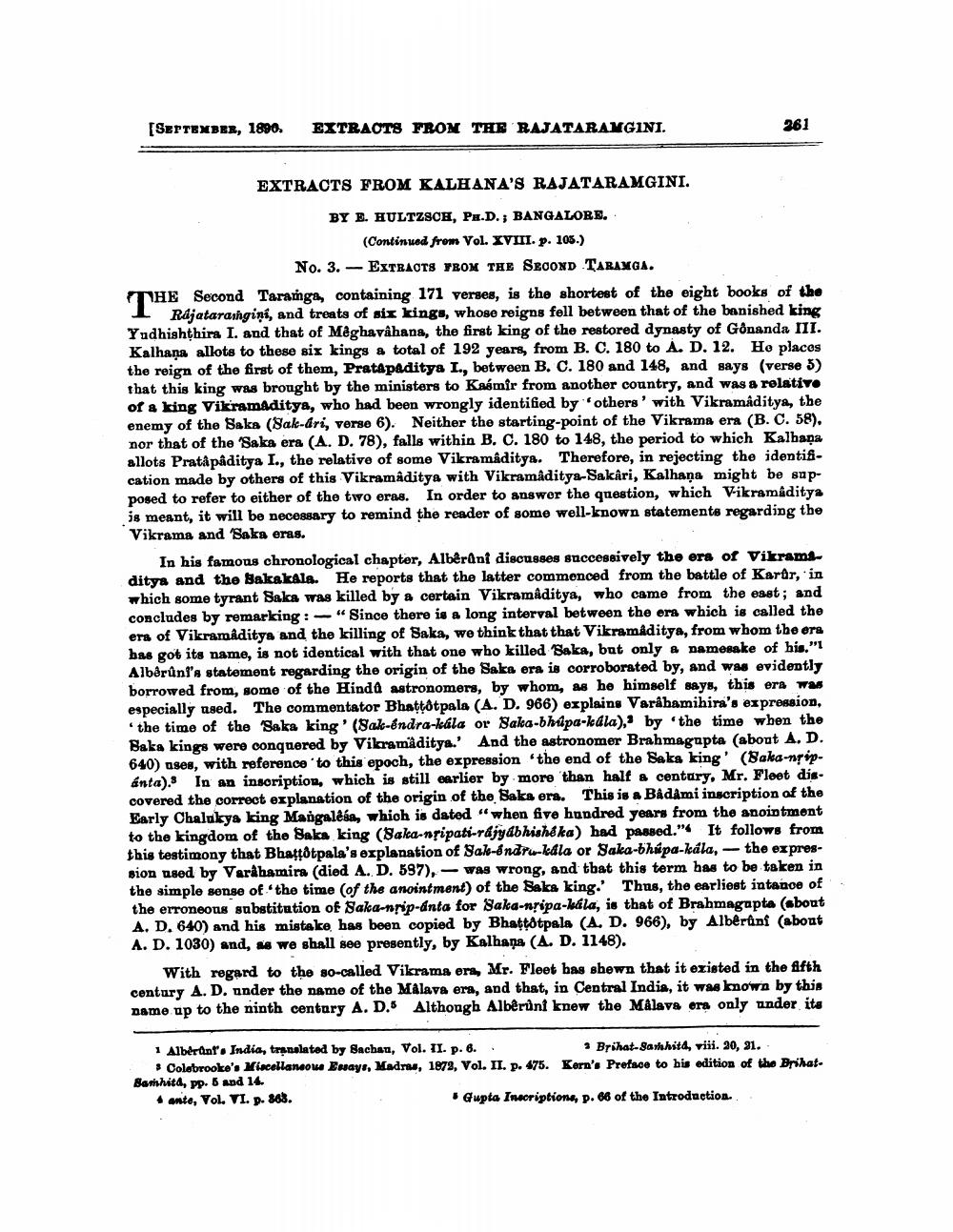________________
[SENTEXBER, 1890.
EXTRAOTS FROM THE RAJATARANGINI.
261
EXTRACTS FROM KALHANA'S RAJATARAMGINI.
BY E. HULTZSCH, PH.D.; BANGALORE.
(Continued from Vol. XVIII. p. 105.)
No. 3. - EXTRACTS FROM THE SECOND TABANGA. THE Second Taramga, containing 171 verses, is the shortest of the eight books of the
1 Rajatarangini, and treats of six kings, whose reigns fell between that of the banished king Yudhishthira I. and that of Maghavahana, the first king of the restored dynasty of Gônanda III. Kalhaņa allots to these six kings a total of 192 years, from B. C. 180 to A. D. 12. Ho places the reign of the first of them, Pratápaditya L., between B. C. 180 and 148, and says (verse 5) that this king was brought by the ministers to Kasmir from another country, and was a relativo of a king Vikramaditya, who had been wrongly identified by others' with Vikramaditya, the enemy of the Saka (Sak-dri, verse 6). Neither the starting point of the Vikrama era (B. C. 58). nor that of the 'Saka era (A, D. 78), falls within B. C. 180 to 148, the period to which Kalbana allots Pratâpâditya I., the relative of some Vikramaditya. Therefore, in rejecting the identification made by others of this Vikramaditya with Vikramaditya-Sakari, Kalhaņa might be supposed to refer to either of the two eras. In order to answer the question, which Vikramaditya is meant, it will be necessary to remind the reader of some well-known statements regarding the Vikrama and 'Saka eras.
In his famous chronological chapter, Albêráni discusses successively the era of Vikramsditya and the Bakakala. He reports that the latter commenced from the battle of Karir, in which some tyrant Saka was killed by a certain Vikramaditya, who came from the east; and concludes by remarking: -"Since there is a long interval between the era which is called the era of Vikramaditya and the killing of Saka, we think that that Vikramaditya, from whom the era bas got its name, is not identical with that one who killed Saka, but only a namesake of his." Albêrûni's statement regarding the origin of the Saks era is corroborated by, and was evidently borrowed from, some of the Hindů astronomers, by whom, as he himself says, this era was especially used. The commentator Bhattpala (A. D. 966) explains Varábamihira's expression,
the time of the Saka king' (Sal-andra-kala or Baka-bhupa-kdla),' by the time when the Baka kings were conquered by Vikramaditya.' And the astronomer Brahmagupta (about A. D. 640) ases, with reference to this epoch, the expression the end of the Saks king' (Baka-nsipánta). In an insoription, which is still earlier by more than half a century, Mr. Fleet discovered the correot explanation of the origin of the Saks era. This is a Badami inscription of the Early Chalukya king Mangalêsa, which is dated “when five hundred years from the anointment to the kingdom of the Saks king (Saka-nsipati-rajyabhisheka) had passed." It follows from this testimony that Bhattpala's explanation of Sak-endru-kála or Saka-bhápa-kála, - the expression used by Vardhamira (died A. D. 597), was wrong, and that this term has to be taken in the simple sense of the time of the anointment) of the Baka king. Thus, the earliest intance of the erroneous substitution of Saka-nrip-anta for Saka-nripa-bála, is that of Brahmagapta (about A. D. 640) and his mistake has been copied by Bhattotpala (A. D. 966), by Albêrini (about A. D. 1030) and, as we shall see presently, by Kalhana (A. D. 1148).
With regard to the so-called Vikrama era, Mr. Fleet bas shewn that it existed in the fifth century A. D. under the name of the Malava era, and that, in Central India, it was known by this Dame up to the ninth century A. D. Although Albêrunt knew the Malava era only under its
1 Alberunt. India, translated by Bachan, Vol. II. p. 6..
. Brihat-Samhitd, viii. 20, 21. Colebrooke's Miscellaneowa Eways, Madras, 1872, Vol. II. p. 475. Kern'. Preface to his edition of the Brihat. Samhita, pp. 6 and 14. * ante, Vol. VI. p. 883.
• Gupta Inscriptions, p. 66 of the Introduction.




